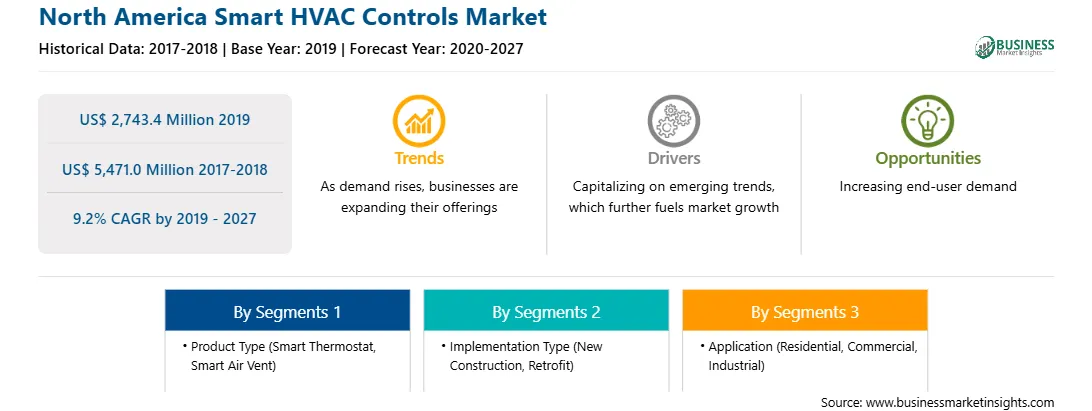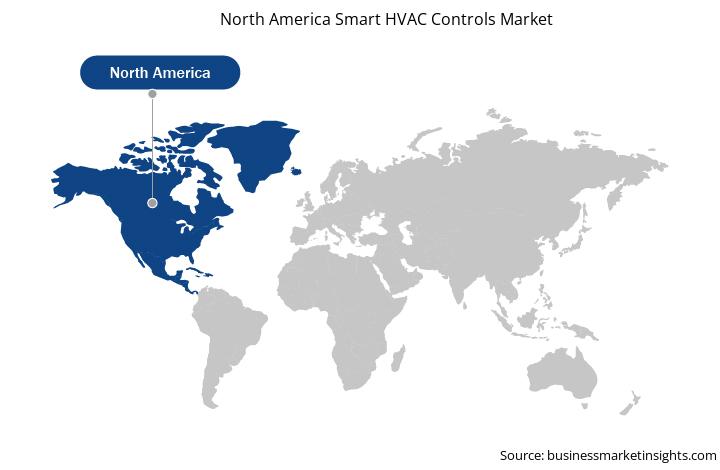Market Introduction
Smart heating, ventilation, and air conditioning (HVAC) systems is an integral part of facilities and smart buildings management. Smart HVAC controls offers a wide range of sensors and advanced control technologies which helps detect operational needs of buildings. Rising penetration of the Internet of Things (IoT) is one of the major factors contributing to the growth of the smart HVAC controls market, as nowadays, the manufacturers are integrating IoT technology with HVAC systems. Manufacturers program the systems to work with other linked systems, such as door locks and powered window shades, in real-time. Increasing connectivity of machine to machine (M2M) is encouraging users to use HVAC units with intelligent machine systems. In addition, companies use components, such as sensors, to collect real-time data and monitor indoor environmental conditions to enhance the user experience. Increasing use of intelligent sensor technology would propel the demand for smart HVAC controls during the forecast period. However, the lack of awareness of potential benefits of smart HVAC controls and associated costs of installation and maintenance may hinder the market growth.
Furthermore, the governments' energy management initiatives for environmental degradation are also expected to propel the North America smart HVAC controls market growth. Regulations have been introduced in several countries to ensure that buildings have smart heating and cooling systems to enhance their energy efficiency. According to a study conducted by the American Council for an Energy-Efficient Economic, the use of smart HVAC saves energy cost by approx. 5–15%. Also, a large number of well-funded startups is offering innovative HVAC solutions and services. With the presence of leading manufacturers—such as Daikin North America LLC, Honeywell International Inc., and Lennox International—focused on the R&D and production of smart HVAC controls, the US is expected to dominate the smart HVAC controls market in North America during the forecast period.
Strategic insights for the North America Smart HVAC Controls provides data-driven analysis of the industry landscape, including current trends, key players, and regional nuances. These insights offer actionable recommendations, enabling readers to differentiate themselves from competitors by identifying untapped segments or developing unique value propositions. Leveraging data analytics, these insights help industry players anticipate the market shifts, whether investors, manufacturers, or other stakeholders. A future-oriented perspective is essential, helping stakeholders anticipate market shifts and position themselves for long-term success in this dynamic region. Ultimately, effective strategic insights empower readers to make informed decisions that drive profitability and achieve their business objectives within the market. The geographic scope of the North America Smart HVAC Controls refers to the specific areas in which a business operates and competes. Understanding local distinctions, such as diverse consumer preferences (e.g., demand for specific plug types or battery backup durations), varying economic conditions, and regulatory environments, is crucial for tailoring strategies to specific markets. Businesses can expand their reach by identifying underserved areas or adapting their offerings to meet local demands. A clear market focus allows for more effective resource allocation, targeted marketing campaigns, and better positioning against local competitors, ultimately driving growth in those targeted areas.
North America Smart HVAC Controls Strategic Insights

North America Smart HVAC Controls Report Scope
Report Attribute
Details
Market size in 2019
US$ 2,743.4 Million
Market Size by 2027
US$ 5,471.0 Million
Global CAGR (2019 - 2027)
9.2%
Historical Data
2017-2018
Forecast period
2020-2027
Segments Covered
By Product Type
By Implementation Type
By Application
Regions and Countries Covered
North America
Market leaders and key company profiles
North America Smart HVAC Controls Regional Insights

Market Overview and Dynamics
The North America smart HVAC controls market was valued at US$ 2,743.4 million in 2019 and is expected to grow at a CAGR of 9.2% during the forecast period of 2020 to 2027 to reach US$ 5,471.0 million by 2027.
The rising importance of indoor air quality and load reduction is one of the major factors expected to drive the North America smart HVAC controls market during the forecast period. Moreover, the positive impact of codes and standards is another major factor driving the growth of smart HVAC controls market.
In North America, the US, Canada, and Mexico are major economies. The region is witnessing growth in its manufacturing and construction industries. The tech-giants are continuously contributing to technological advancements, which has created a stir in the competitive market across the region. The region's population is more inclined toward technological developments due to high spending power. The companies in this region are continuously enhancing their overall business processes to meet customer demand for high-quality products and services efficiently.
The US dominated the smart HVAC controls market in 2019 and is expected to dominate the market with the largest share during the forecast period. The growth of the smart HVAC controls market in the US is mainly driven by the considerable growth of several new HVAC based equipment manufacturing companies each year, which are funded by several capitalists, thereby increasing the market scope. Further, the federal government focuses on bringing back the manufacturing companies to the US, which are shifted overseas to achieving cost-competitiveness. The government announced its plans to provide tax cuts to manufacturers with facilities in the US and impose higher tariffs on overseas manufacturers. These initiatives by government would further boost the country's manufacturing industry's growth, which would accelerate the smart HVAC controls market in the US during the forecast period.
Key Market Segments
Based on product type, in 2019, the smart air vent segment held the largest share of the North America smart HVAC controls market. Smart thermostats use door sensors and high precision motion to save energy by switching off automatically when residents are sleeping or are outside the home. In addition, smart thermostat helps find perfect climate in the room and ensures optimal home energy consumption. Furthermore, increasing adoption of digitalization could save around 10% of total energy consumption in commercial and residential buildings by 2040, according to the International Energy Agency (IEA). This has gradually led to an increase in number of automated buildings, resulting in expanding the smart HVAC controls market.
In terms of implementation type, the retrofit segment contributed a substantial share in 2019. Increased product launches and developments contribute to the growth of the North America smart HVAC controls market for the retrofit segment. For example, Siemens RDS110.R—the wireless smart thermostat and its accessories—represents a new heating control retrofit solution for light commercial and residential buildings. Such product portfolios are likely to drive the market growth for the retrofit segment during the forecast period.
Based on application, in 2019, the residential segment held the largest share of the North America smart HVAC controls market. Due to airtight building infrastructure with inefficient ventilation systems, the adoption rate of smart HVAC controls is significantly increasing in order to reduce health issues. Furthermore, due to increasing use of these systems integrated with smart homes, the residential segment is expected to gain momentum during the forecast period.
Major Sources and Companies Listed
A few of the major primary and secondary sources referred to while preparing this report on the North America smart HVAC controls market are company websites, annual reports, financial reports, national government documents, and statistical database. Major companies listed in the smart HVAC controls market report are Honeywell International Inc.; Siemens AG; DAIKIN INDUSTRIES, Ltd.; Carrier Global Corporation; Emerson Electric Co.; Haier Group Corporation; Hitachi, Ltd.; LG Electronics; Lennox International Inc.; and Trane Technologies plc.
Reasons to Buy Report
North America Smart HVAC Controls Market Segmentation
By
Implementation Type
By Application
Company Profiles
The North America Smart HVAC Controls Market is valued at US$ 2,743.4 Million in 2019, it is projected to reach US$ 5,471.0 Million by 2027.
As per our report North America Smart HVAC Controls Market, the market size is valued at US$ 2,743.4 Million in 2019, projecting it to reach US$ 5,471.0 Million by 2027. This translates to a CAGR of approximately 9.2% during the forecast period.
The North America Smart HVAC Controls Market report typically cover these key segments-
The historic period, base year, and forecast period can vary slightly depending on the specific market research report. However, for the North America Smart HVAC Controls Market report:
The North America Smart HVAC Controls Market is populated by several key players, each contributing to its growth and innovation. Some of the major players include:
The North America Smart HVAC Controls Market report is valuable for diverse stakeholders, including:
Essentially, anyone involved in or considering involvement in the North America Smart HVAC Controls Market value chain can benefit from the information contained in a comprehensive market report.